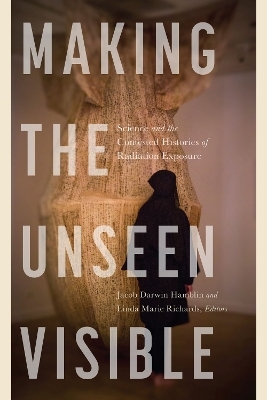
Making the Unseen Visible
Science and the Contested Histories of Radiation Exposure
Seiten
2024
Oregon State University (Verlag)
978-0-87071-253-1 (ISBN)
Oregon State University (Verlag)
978-0-87071-253-1 (ISBN)
Scholarship on nuclear topics has largely happened on a case study basis, with books focusing on individual disasters or locations. Making the Unseen Visible brings a variety of current community and scholarly work together to create a clearer, larger web uniting nuclear humanities research across time and geography.
Many of the effects of nuclear fallout and radiation have been intentionally hidden by governments around the world. Public knowledge of these effects has been driven by activists who have demanded recognition and justice. These activists often exist in tension with government and academic experts, whose assessments of “acceptable risk” can be markedly different from those of the people affected by nuclear radiation. Many downwinders fought for years, in the press and in the courts, to have their health and environmental concerns taken seriously. Although these battles have taken place worldwide, one of the most significant has been the extended legal battle around the Hanford Nuclear Reservation in Washington and the controversial Hanford Environmental Dose Reconstruction Project. From 2017 to 2020, Jacob Hamblin and Linda Richards ran the OSU Downwinders Project, an NSF-sponsored project supporting research and scholarship on the Hanford downwinders cases and the dose reconstruction project. Additionally, each summer the project team sponsored a workshop that brought a variety of stakeholders together to explore the science, history, and lived experiences of nuclear exposure. These workshops took a broad view of nuclear exposure, beyond Hanford, beyond the United States, and beyond academia. Community members and activists presented their testimonies and creative work alongside scholars studying exposure worldwide.
Making the Unseen Visible collects the best work arising from the project and its workshops. Scholarly research chapters and reflective essays cover topics and experiences ranging from colonial nuclear testing in North Africa to Hiroshima survivor stories to uranium mining in the Navajo Nation to battles over public memory around Hanford. Scholarship on nuclear topics has largely happened on a case study basis, with books focusing on individual disasters or locations. Making the Unseen Visible aims to bring a variety of current community and scholarly work together to create a clearer, larger web uniting nuclear humanities research across time and geography.
Many of the effects of nuclear fallout and radiation have been intentionally hidden by governments around the world. Public knowledge of these effects has been driven by activists who have demanded recognition and justice. These activists often exist in tension with government and academic experts, whose assessments of “acceptable risk” can be markedly different from those of the people affected by nuclear radiation. Many downwinders fought for years, in the press and in the courts, to have their health and environmental concerns taken seriously. Although these battles have taken place worldwide, one of the most significant has been the extended legal battle around the Hanford Nuclear Reservation in Washington and the controversial Hanford Environmental Dose Reconstruction Project. From 2017 to 2020, Jacob Hamblin and Linda Richards ran the OSU Downwinders Project, an NSF-sponsored project supporting research and scholarship on the Hanford downwinders cases and the dose reconstruction project. Additionally, each summer the project team sponsored a workshop that brought a variety of stakeholders together to explore the science, history, and lived experiences of nuclear exposure. These workshops took a broad view of nuclear exposure, beyond Hanford, beyond the United States, and beyond academia. Community members and activists presented their testimonies and creative work alongside scholars studying exposure worldwide.
Making the Unseen Visible collects the best work arising from the project and its workshops. Scholarly research chapters and reflective essays cover topics and experiences ranging from colonial nuclear testing in North Africa to Hiroshima survivor stories to uranium mining in the Navajo Nation to battles over public memory around Hanford. Scholarship on nuclear topics has largely happened on a case study basis, with books focusing on individual disasters or locations. Making the Unseen Visible aims to bring a variety of current community and scholarly work together to create a clearer, larger web uniting nuclear humanities research across time and geography.
Jacob Darwin Hamblin is professor of history at Oregon State University and author of five books, including The Wretched Atom: America’s Global Gamble with Peaceful Nuclear Technology. Linda Marie is a senior instructor of history at Oregon State University and a scholar of anti-nuclear activism; her first book, Human Rights and Nuclear Wrongs, is forthcoming from West Virginia University Press.
| Erscheinungsdatum | 05.12.2023 |
|---|---|
| Zusatzinfo | 4 b&w photos, 3 tables |
| Verlagsort | Corvallis, OR |
| Sprache | englisch |
| Maße | 152 x 229 mm |
| Gewicht | 272 g |
| Themenwelt | Naturwissenschaften ► Biologie ► Ökologie / Naturschutz |
| Naturwissenschaften ► Chemie ► Physikalische Chemie | |
| Naturwissenschaften ► Physik / Astronomie ► Atom- / Kern- / Molekularphysik | |
| ISBN-10 | 0-87071-253-5 / 0870712535 |
| ISBN-13 | 978-0-87071-253-1 / 9780870712531 |
| Zustand | Neuware |
| Haben Sie eine Frage zum Produkt? |
Mehr entdecken
aus dem Bereich
aus dem Bereich


